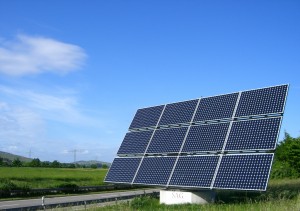The German Energy Experiment

Photo: Schwarzerkater (Flickr)
The rapid change in Germany’s energy mix – the Energiewende, or “energy shift”—is readily apparent to any visitor. Towering wind turbines sprout from ridges, just as across much of Europe and parts of the U.S. The bigger surprise—and bigger change in just the last few years—is the increase in solar deployment. Not just rooftops, but entire hillsides are covered with massed ranks of photovoltaic panels, like silicon supplicants to some futuristic sun god. To me, their juxtaposition adds to the beauty of the otherwise pastoral German countryside, though of course not all agree—and admittedly the biomass and waste combustion that makes up much of Germany’s renewable energy generation lacks aesthetic appeal.
Figuring out what such a rapid transition will mean for Germany is hard. But there’s good reason to believe German efforts will yield global benefits, whether they’re a model worth following or not.
Germany is not alone in experiencing big changes in its energy mix in recent years. In the U.S., natural gas and to a much lesser extent wind power have displaced large amounts of coal generation. The size of these changes is comparable to those in Germany.
Electricity Generation by Fuel Source, 2009-2012 (Sources: EIA and Bundesverband der Energie- und Wasserwirtschaft)
The standard story is that these shifts—American and German—have different sources. The Energiewende, most claim, is driven by government intervention, while the U.S. coal-gas shift is driven by market forces, chiefly cheap shale gas. But this story is only partly true. In the U.S., recent and expected future regulations have increased the real and perceived costs of coal generation, accelerating the move toward alternatives, though changes in gas prices and energy demand probably are the biggest factors. Federal subsidies have underpinned growth in wind generation.
There are also market-driven elements to the German story. Solar deployment has been driven by sustained and dramatic declines in the cost of solar panels (though some argue these low prices are due to Chinese industrial policy). Cheaper panels mean solar is more profitable under Germany’s feed-in tariffs guaranteeing access to the grid and minimum prices for renewable generation.
These German policies have their critics and critiques. They are undoubtedly expensive. Especially in combination with the country’s decision to end their use of nuclear power, the move towards renewables is a massive bet, arguably with the viability of the country’s economy and industrial base at stake. It is possible Germany will slow the pace of the Wende, perhaps by reducing the feed-in tariff. But the policy remains broadly popular and is officially supported by most parties. Any change will not come until after this year’s election.
But from an American point of view, the Wende is almost unambiguously beneficial. Most obviously, it contributes to the falling cost of renewables. Just as early Danish commitment to wind power in past years drove turbine costs down and helped made widespread deployment from Scotland to North Dakota more attractive, German solar expansion should drive innovation and learning-by-doing that make future solar deployment cheaper—though solar costs remain persistently higher in the US than in Germany.
But there’s another benefit to the Wende—Germany is conducting a policy experiment as well as a technological one. The feed-in tariff and other policies give us evidence on how governments can most cost-effectively promote renewables. Even if the U.S. or other countries don’t emulate Germany, they can implement better policies as a result of the German experience. This exchange should not be a one-way street, either. Germany can undoubtedly learn from the U.S. experience with unconventional energy development as well.
A third benefit is slipperier. The Wende is a bold move that may show what is possible, inspiring other countries to follow (in addition to making it cheaper for them to do so). In this respect, the high risk of the Wende is a feature, not a bug. Timid policy moves no one.
In all three cases, much of the benefit of the Wende accrues not to Germany, but to other countries. This is of course true even for the primary goal of the policy, preventing climate change. Indeed, many Germans see the Wende in moral terms as much or more than economic ones—the risks and investments are about global altruism, or are simply the morally correct path. That makes characterizing the policy in cost-benefit terms much harder.
Germany is taking big risks. The world benefits greatly if their transition to a very low-carbon economy succeeds. But the benefits will probably be significant even if the policy ultimately fails. Even skeptics of the Energiewende—at least those outside Germany—therefore should be thankful for it.
About Nathan Richardson
Nathan Richardson is a visiting fellow at RFF and an associate professor at the University of South Carolina School of Law. A lawyer by training, Nathan's research focuses on energy and climate policy, particularly regulatory tools available under US law.
- Web |
- More Posts (96)

 Subscribe; to our RSS Feed
Subscribe; to our RSS Feed Tweets by @RFF_org
Tweets by @RFF_org 
Nathan, Why do “solar costs remain persistently higher in the US than Germany”? Is it due to a direct or indirect subsidy?
This is a good question, but I don’t know the answer. It’s not (apparently) due to subsidies. According to Josh Linn (who knows more about solar than I do), it’s currently unclear even to experts.